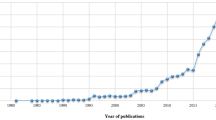Abstract
This paper adopts two mathematical approaches, data envelopment analysis (DEA) and grey relation analysis (GRA) to measure DEA efficiency using the sample of 69 listed US internet companies. A total of 40 indicators were initially selected for the efficiency evaluation, with 21 related to DEA-input indicators and 19 to DEA-output indicators. Eight representative indicators selected using GRA are subsequently used as the input and output indicators in the DEA analysis. The empirical result also shows that 10 out of 69 dot com firms are CCR-efficient in DEA Efficiency.

Similar content being viewed by others
Notes
The threshold of 0.75 appears arbitrary. This is a problem of pragmatic character, which is not easily resolved on theoretical ground. It is similar to using 60 marks to pass students in examinations, for example.
References
Barua A, Brockett PL, Cooper WW, Deng H, Parker BR, Ruefli TW and Whinstona A (2004). DEA evaluations of long- and short-run efficiencies of digital vs. physical product ‘dot com’ companies . Socio Econ Plan Sci 38: 233–253.
Boitano M (2000). NASDAQ's bloody April puts the ‘E’ back in P/E . Fortune 141: 454–455.
Cesar VO and Benjamin MT (2005). An international comparison of banking sectors: A DEA approach . Global Econ Rev 34: 291–307.
Charnes A, Cooper WW and Rhodes E (1978). Measuring the efficiency of decision making units . Eur J Opl Res 2: 429–444.
Chen Y and Zhu J (2003). DEA models for identifying critical performance measures . Ann Opns Res 124: 225–244.
Cheng CW (2002). Outcomes of applying Sun Tzu's scorecard to a Dot. Com company in Taiwan. Int J Strat Plan. November: 2–19.
Deng JL (1982). Control problems of grey systems . Syst Control Lett 5: 288–294.
Deng JL (1989). Introduction to grey system . J Grey Syst 1: 1–24.
Dolbeck A (2005). Valuation of the e-commerce and internet services industry . Weekly Corp Growth Rep Iss 1354: 1–4.
Dolbeck A (2006). Valuation of the e-Commerce and internet services industry . Weekly Corp Growth Rep Iss 1378: 1–4.
Farell MJ (1957). The measurement of productivity efficiency . Journal of the Royal Stat Soc 120: 499–513.
Gollotto JC and Kim S (2003). Market valuation of Dot Com companies: R&D versus Hype . Manage Financ 29(11): 61–72.
Ho CT (2006). Measuring bank operations performance: an approach based on Grey Relation Analysis . J Opl Res Soc 57: 227–349.
Kamssu AJ, Reithel BJ and Ziegelmayer JL (2003). Information technology and financial performance: the impact of being an internet-dependent firm on stock returns . Inform Syst Front 5: 279–288.
Kaplan RS and Norton DP (1996). Using the balanced scorecard as a strategic management system. Harvard Bus Rev 74 (January/February): 75–85.
King AM (2000). Valuing red-hot internet stocks . Strateg Financ 81(10): 28–33.
Kotha S, Rajgopal S and Rindova V (2001). Reputation building and performance: an empirical analysis of the top-50 pure internet firms . Eur Mngt J 19: 571–586.
Luo X (2003). Evaluating the profitability and marketability efficiency of large banks: an application of data envelopment analysis . J Bus Res 56: 627–635.
Paradi JC and Schaffnit C (2004). Commercial branch performance evaluation and results communication in a Canadian bank—A DEA application . E J Opl Res 156: 719–735.
Pethokoukis JM and Vogelstein F (2000). Market mania the stock market has never been more valuable, or more volatile. Here's some help . USNW Report 128(13): 34–42.
Ross SA, Westerfield RW and Jordan BD (2001). Essentials of Corporate Finance, 3rd edn. McGraw-Hill: NY, USA.
Seiford LM and Zhu J (1999). Profitability and marketability of the top 55 U.S. commercial banks . Mngt Sci 45: 1270–1288.
Serrano-Cinca C, Fuertes-Callén Y and Mar-Molinero C (2005). Measuring DEA efficiency in Internet companies . Decis Support Syst 38: 557–573.
Souitaris V and Cohen M (2003). Internet-business or just business? Impact of internet-specific strategies on venture performance . Eur Mngt J 21: 421–437.
Wen HJ, Lim B and Huang HL (2003). Measuring e-commerce efficiency: A data envelopment analysis (DEA) approach . Ind Mngt Data Syst 103: 703–710.
Zhu J (2000). Multi-factor performance measure model with an application to Fortune 500 companies . Eur J Opl Res 123: 105–124.
Author information
Authors and Affiliations
Corresponding author
Rights and permissions
About this article
Cite this article
Bruce Ho, CT. Measuring dot com efficiency using a combined DEA and GRA approach. J Oper Res Soc 62, 776–783 (2011). https://doi.org/10.1057/jors.2010.3
Received:
Accepted:
Published:
Issue Date:
DOI: https://doi.org/10.1057/jors.2010.3




